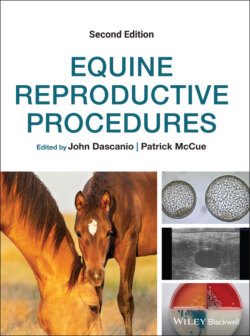Читать книгу Equine Reproductive Procedures - Группа авторов - Страница 24
Оглавление13 Antimicrobiotic Sensitivity Testing
Jillian Bishop1 and Patrick M. McCue2
1 University of Kansas Health System, USA
2 Equine Reproduction Laboratory, Colorado State University, USA
Introduction
A Kirby–Bauer disk diffusion susceptibility test (agar disk diffusion test) is used to evaluate the effectiveness of specific antibiotics against aerobic bacterial organisms under in vitro culture conditions. A known quantity of bacteria are distributed evenly on the surface of the agar plate and a series of paper disks, each impregnated with one antibiotic, are placed on the surface of the agar plate. The zone of growth inhibition around each test disk is a measure of the sensitivity of the organism to the given antibiotic.
Equipment and Supplies
Mueller Hinton (MH) II agar plate: MH‐II agar plates with 5% sheep blood for Gram‐positive β‐hemolytic organisms, MH‐II agar plates without sheep blood for Gram‐negative organisms; sterile swab; antibiotic disk dispenser; antibiotic sensitivity disks: ampicillin 10 μg, amikacin 10 μg, ceftiofur 30 μg, enrofloxacin 5 μg, gentamicin 10 μg, penicillin G 10 units, trimethoprim/sulfamethoxazole 23.75/1.25 μg, ticarcillin 75 μg with clavulanic acid; incubator; measuring device.
Technique
Allow a Mueller Hinton (MH) II agar plate to equilibrate to room temperature. Label the plastic dish bottom (agar side) with the mare’s name, source of sample, and date.
If the bacterium of interest is Gram‐positive and β‐hemolytic, use a MH‐II agar plate with 5% sheep’s blood in order to visualize the colorless colonies and zones of inhibition (e.g., Streptococcus equi subspecies zooepidemicus).
Option 1 for inoculating the MH‐II agar plate:Use a single cotton swab to pick up one to three isolated identical colonies from the original culture plate.Streak the MH‐II agar plate in a painting fashion until the entire plate has been swabbed with the bacteria (Figure 13.1). An example would be:streak three parallel lines down the center of the platestreak the entire plate going perpendicular to the primary three lines; try to cover the entire platerotate the plate 90 degrees and streak the entire plate again; try to cover the entire platerotate the plate 90 degrees and streak the entire plate one last time, ensuring a confluent coverage of the entire plate.
Option 2 for inoculating the MH‐II agar plate:Prepare a bacterial suspension in saline, tryptic soy broth, or MH broth that contains between 1 × 108 and 2 × 108 CFU/ml of the bacteria in question.Pick three to five isolated colonies from the primary plate.Transfer the colonies into the media.Adjust the turbidity to a 0.5 McFarland Standard.Inoculate the plate with the bacterial suspension.
For both options, use the following procedure. Place the antibiotic disk dispenser over the plate and depress the plunger to dispense the disks and gently tamp the antibiotic disks onto the agar surface.
Place the plate in an incubator, agar side up, for 24 hours at 37°C (99°F).Figure 13.1 Pattern of bacterial streaking on a Mueller Hinton II agar plate and placement of antimicrobial disks.Figure 13.2 Antimicrobial susceptibility test. This bacterial organism was sensitive to two antibiotics, intermediate to one, and resistant to the other five antibiotics.
After the incubation period, use a clear ruler to measure the diameter of the zone of inhibition around each disk (Figure 13.2). Measure on the bottom side of the plate viewing through the plate. If adjacent areas of inhibition overlap, measure the radius and multiple by 2.
Record the results in millimeters. Always round up to the next millimeter.
Compare the results with the standard zone of inhibition for each antibiotic provided by the manufacturer and report the result as resistant, intermediate, or susceptible. The zone of inhibition of bacterial growth is different for each antibiotic due to the differences in migration of the different‐sized antibiotic molecules through the agar, the solubility of the antibiotic, and the diffusion properties.
Further Reading
1 Quinn PJ, Markey BK, Leonard FC, Hartigan P, Fanning S, FitzPatrick ES. 2011. Antibacterial agents. In: Veterinary Microbiology and Microbial Disease, 2nd edn. Chichester: Wiley Blackwell, pp. 143–8.
2 Ricketts SW. 2011. Uterine and clitoral cultures. In: McKinnon AO, Squires EL, Vaala WE, Varner DD (eds). Equine Reproduction, 2nd edn. Ames, IA: Wiley Blackwell, pp. 1963–78.
3 Songer J, Post K. 2005. Antimicrobial susceptibility testing and principles of antimicrobial therapy. In: Veterinary Microbiology Bacterial and Fungal Agents of Animal Disease. Amsterdam: Elsevier, pp. 21–31.
